Numerical Study on the Aerodynamic Heating Characteristics of the Cantilevered Injection System for Oblique Detonation Engine Inlets
Abstract
:1. Introduction
2. Numerical Scheme
2.1. Governing Equations
2.2. Geometry and Boundary Conditions
2.3. Grid Independence Study
2.4. Code Validation
3. Results and Discussion
3.1. Leading Edge: Bow Shock Wave/Boundary Layer Interaction
3.2. Inlet Wall Surface: Crossing Shock Wave/Boundary Layer Interaction
3.3. Downstream of the Injector Sidewall: Crossing Shock Wave Interaction
4. Conclusions
- (1)
- When the adverse pressure gradient is strong enough to significantly separate the boundary layer at the leading edge, the peak heat flux occurs at the location of the minimum boundary-layer thickness around the reattachment point, which can reach up to 70 times the heat flux value of the undisturbed flat plate.
- (2)
- Crossing shock wave/boundary layer interaction between injectors can lead to complex surface flow topology and distribution of heat flux along the inlet wall below the injector, with three patterns observed, i.e., partial separation, completely regular separation, and completely nonregular separation. When complete separation occurs, the boundary layer is completely lifted from the flat plate, followed by a series of separations and reattachments which induce a complex heat flux distribution. Moreover, for the completely nonregular separation, the main separation line is detached to the upstream of the injector, and separation is greatly advanced accompanied by a greatly expanded separation zone.
- (3)
- Three-dimensional shock wave/shock wave interaction of crossing shock waves between injectors can induce complex shock structures. If the reflected shock wave strikes the injector side, separation of the boundary layer of the sidewall surface occurs followed by flow reattachment. High heat flux strips appear along the reattachment lines, while the peak heat flux can reach the same magnitude as the extremum value at the reattachment point of the injector leading edge.
Author Contributions
Funding
Data Availability Statement
Conflicts of Interest
References
- Wolański, P. Detonative propulsion. Proc. Combust. Inst. 2013, 34, 125–158. [Google Scholar] [CrossRef]
- Zhang, Y.; Fang, Y.; Ng, H.D.; Teng, H. Numerical investigation on the initiation of oblique detonation waves in stoichiometric acetylene–oxygen mixtures with high argon dilution. Combust. Flame 2019, 204, 391–396. [Google Scholar] [CrossRef]
- Zhang, Z.; Ma, K.; Zhang, W.; Han, X.; Liu, Y.; Jiang, Z. Numerical investigation of a Mach 9 oblique detonation engine with fuel pre-injection. Aerosp. Sci. Technol. 2020, 105, 106054. [Google Scholar] [CrossRef]
- Kailasanath, K. Review of Propulsion Applications of Detonation Waves. AIAA J. 2000, 38, 1698–1708. [Google Scholar] [CrossRef]
- Braun, E.M.; Lu, F.K.; Wilson, D.R.; Camberos, J.A. Airbreathing rotating detonation wave engine cycle analysis. Aerosp. Sci. Technol. 2013, 27, 201–208. [Google Scholar] [CrossRef]
- Niu, S.; Yang, P.; Wang, K.; Teng, H. Unsteady Oblique Detonation Waves in a Tunnel Induced by Inflow Mach Number Variation. Aerospace 2023, 10, 330. [Google Scholar] [CrossRef]
- Parent, B.; Sislian, J.P.; Schumacher, J. Numerical Investigation of the Turbulent Mixing Performance of a Cantilevered Ramp Injector. AIAA J. 2002, 40, 1559–1566. [Google Scholar] [CrossRef]
- Sislian, J.P.; Martens, R.P.; Schwartzentruber, T.E.; Parent, B. Numerical Simulation of a Real Shcramjet Flowfield. J. Propuls. Power 2006, 22, 1039–1048. [Google Scholar] [CrossRef]
- Wang, Y.-W.; Sislian, J.P. Numerical Simulation of Gaseous Hydrocarbon Fuel Injection in a Hypersonic Inlet. J. Propuls. Power 2010, 26, 1114–1124. [Google Scholar] [CrossRef]
- Veraar, R.; Mayer, A.; Verreault, J.; Stowe, R.; Farinaccio, R.; Harris, P. Proof-of-Principle Experiment of a Shock-Induced Combustion Ramjet. In Proceedings of the 16th AIAA/DLR/DGLR International Space Planes and Hypersonic Systems and Technologies Conference, Bremen, Germany, 19–22 October 2009. [Google Scholar]
- Hsu, K.-Y.; Carter, C.; Gruber, M.; Tam, C.-J. Mixing Study of Strut Injectors in Supersonic Flows. In Proceedings of the 45th AIAA/ASME/SAE/ASEE Joint Propulsion Conference and Exhibit 2009, Denver, CO, USA, 2–5 August 2009. [Google Scholar] [CrossRef]
- Hung, C.-M.; Buning, P.G. Simulation of blunt-fin-induced shock-wave and turbulent boundary-layer interaction. J. Fluid Mech. 1985, 154, 163–185. [Google Scholar] [CrossRef]
- Tutty, O.R.; Roberts, G.T.; Schuricht, P.H. High-speed laminar flow past a fin–body junction. J. Fluid Mech. 2013, 737, 19–55. [Google Scholar] [CrossRef]
- Quan, P.; Yi, S.; Wu, Y.; Zhu, Y.; He, L. Experimental Investigation on the Effects of Swept Angles on Blunt Fin-Induced Flow. AIAA J. 2015, 53, 2805–2810. [Google Scholar] [CrossRef]
- Knutson, A.; GS, S.; Candler, G.V. Direct Numerical Simulation of Mach 6 Flow over a Cone with a Highly Swept Fin. In Proceedings of the 2018 AIAA Aerospace Sciences Meeting, Kissimmee, FL, USA, 8–12 January 2018. [Google Scholar]
- Mortazavi, M.; Knight, D. Simulation of Hypersonic-Shock-Wave–Laminar-Boundary-Layer Interaction over Blunt Fin. AIAA J. 2019, 57, 3506–3523. [Google Scholar] [CrossRef]
- Zhang, F.; Yi, S.; Xu, X.; Niu, H.; Lu, X. A swept fin-induced flow field with different height mounting gaps. Chin. J. Aeronaut. 2021, 34, 148–162. [Google Scholar] [CrossRef]
- Gang, D.; Yi, S.; Zhang, F.; Niu, H. Effects of sweep angles on turbulent separation behaviors induced by blunt fin. Chin. J. Aeronaut. 2022, 35, 90–97. [Google Scholar] [CrossRef]
- Dolling, D.S.; Bogdonoff, S.M. Blunt fin-induced shock wave/turbulent boundary-layer interaction. AIAA J. 1982, 20, 1674–1680. [Google Scholar] [CrossRef]
- Schuricht, P.; Roberts, G. Hypersonic interference heating induced by a blunt fin. In Proceedings of the 8th AIAA International Space Planes and Hypersonic Systems and Technologies Conference, Norfolk, VA, USA, 27–30 April 1998. [Google Scholar]
- Garrison, T.; Settles, G. Flowfield visualization of crossing shock-wave/boundary-layer interactions. In Proceedings of the 30th Aerospace Sciences Meeting and Exhibit, Reno, NV, USA, 6–9 January 1992. [Google Scholar]
- Garrison, T.; Settles, G. Interaction strength and model geometry effects on the structure of crossing-shock wave/turbulent boundary-layer interactions. In Proceedings of the 31st Aerospace Sciences Meeting, Reno, NV, USA, 11–14 January 1993. [Google Scholar]
- Garrison, T.J.; Settles, G.S.; Narayanswami, N.; Knight, D.; Horstman, C.C. Flowfield surveys and computations of a crossing-shock wave/boundary-layer interaction. AIAA J. 1996, 34, 50–56. [Google Scholar] [CrossRef]
- Garrison, T.J.; Settles, G.S.; Narayanswami, N.; Knight, D.D. Laser interferometer skin-friction measurements of crossing-shock-wave/turbulent-boundary-layer interactions. AIAA J. 1994, 32, 1234–1241. [Google Scholar] [CrossRef]
- Zheltovodov, A.; Maksimov, A.I.; Shevchenko, A. Topology of three-dimensional separation under the conditions of symmetric interaction of crossing shocks and expansion waves with turbulent boundary layer. Thermophys. Aeromech. 1998, 5, 293–312. [Google Scholar]
- Zheltovodov, A.; Maksimov, A.; Gaitonde, D.; Visbal, M.; Shang, J. Experimental and Numerical Study of Symmetric Interaction of Crossing Shocks and Expansion Waves with a Turbulent Boundary Layer. Thermophys. Aeromech. 2016, 7, 155–171. [Google Scholar]
- Thivet, F.; Knight, D.D.; Zheltovodov, A.A.; Maksimov, A.I. Insights in Turbulence Modeling for Crossing-Shock-Wave/Boundary-Layer Interactions. AIAA J. 2001, 39, 985–995. [Google Scholar] [CrossRef]
- Gaitonde, D.; Shang, J.S. Structure of a turbulent double-fin interaction at Mach 4. AIAA J. 1995, 33, 2250–2258. [Google Scholar] [CrossRef]
- Borovoy, V.; Egorov, I.; Maximenko, A.; Mosharov, V.; Radchenko, V.; Skuratov, A.; Struminskaya, I. Three-dimensional shock-wave/boundary-layer interaction at the presence of entropy layer. Prog. Flight Phys. 2013, 5, 327–348. [Google Scholar] [CrossRef]
- Borovoy, V.; Egorov, I.; Mosharov, V.; Radchenko, V.; Skuratov, A.; Struminskaya, I. Entropy-Layer Influence on Single-Fin and Double-Fin/Boundary-Layer Interactions. AIAA J. 2016, 54, 443–457. [Google Scholar] [CrossRef]
- Seckin, S.; Mears, L.J.; Song, M.; Zigunov, F.; Sellappan, P.; Alvi, F.S. Surface Properties of Double-Fin Generated Shock-Wave/Boundary-Layer Interactions. In Proceedings of the AIAA SCITECH 2022 Forum, San Diego, CA, USA, 3–7 January 2022. [Google Scholar]
- Jiang, Z. Experiments and development of Long-test-duration Hypervelocity Detonation-driven Shock Tunnel (LHDst). In Proceedings of the 52nd Aerospace Sciences Meeting, National Harbor, MD, USA, 13–17 January 2014. [Google Scholar]
- Jiang, Z.; Yu, H. Theories and technologies for duplicating hypersonic flight conditions for ground testing. Natl. Sci. Rev. 2017, 4, 290–296. [Google Scholar] [CrossRef]
- Jiang, Z.; Zhang, Z.; Liu, Y.; Wang, C.; Luo, C. Criteria for hypersonic airbreathing propulsion and its experimental verification. Chin. J. Aeronaut. 2021, 34, 94–104. [Google Scholar] [CrossRef]
- Zhang, Z.; Wen, C.; Yuan, C.; Liu, Y.; Han, G.; Wang, C.; Jiang, Z. An experimental study of formation of stabilized oblique detonation waves in a combustor. Combust. Flame 2022, 237, 111868. [Google Scholar] [CrossRef]
- Chakravarthy, S. A unified-grid finite volume formulation for computational fluid dynamics. Int. J. Numer. Methods Fluids 1999, 31, 309–323. [Google Scholar] [CrossRef]
- Lin, M.; Wang, C.; Peng, J.; Jiang, Z. Simulation on Three-Dimensional Shock Interactions and Aerodynamic Heating Between Body and Wing. AIAA J. 2022, 60, 2085–2096. [Google Scholar] [CrossRef]
- Peng, J.; Luo, C.T.; Han, Z.J.; Hu, Z.M.; Han, G.L.; Jiang, Z.L. Parameter-correlation study on shock–shock interaction using a machine learning method. Aerosp. Sci. Technol. 2020, 107, 106247. [Google Scholar] [CrossRef]
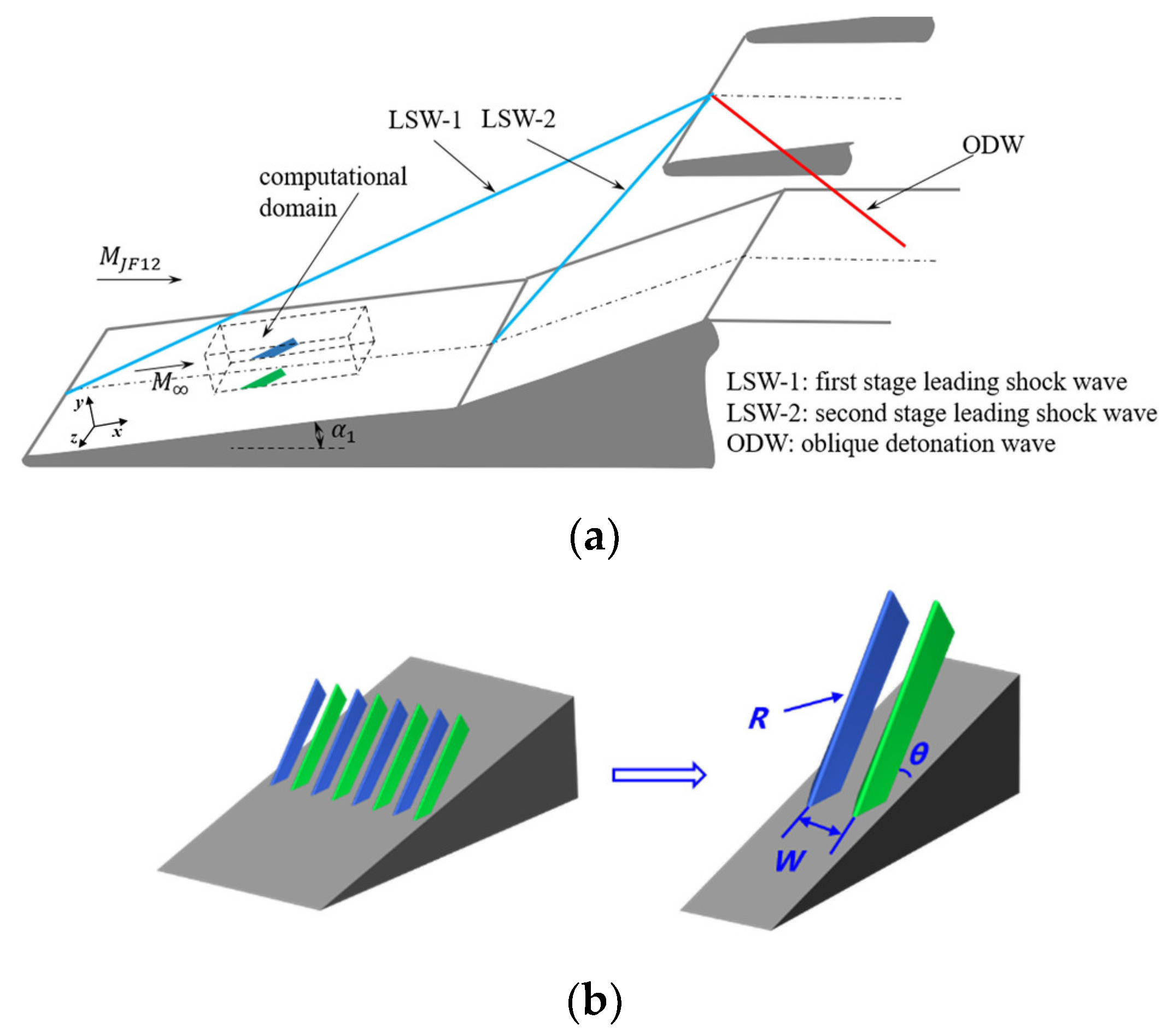
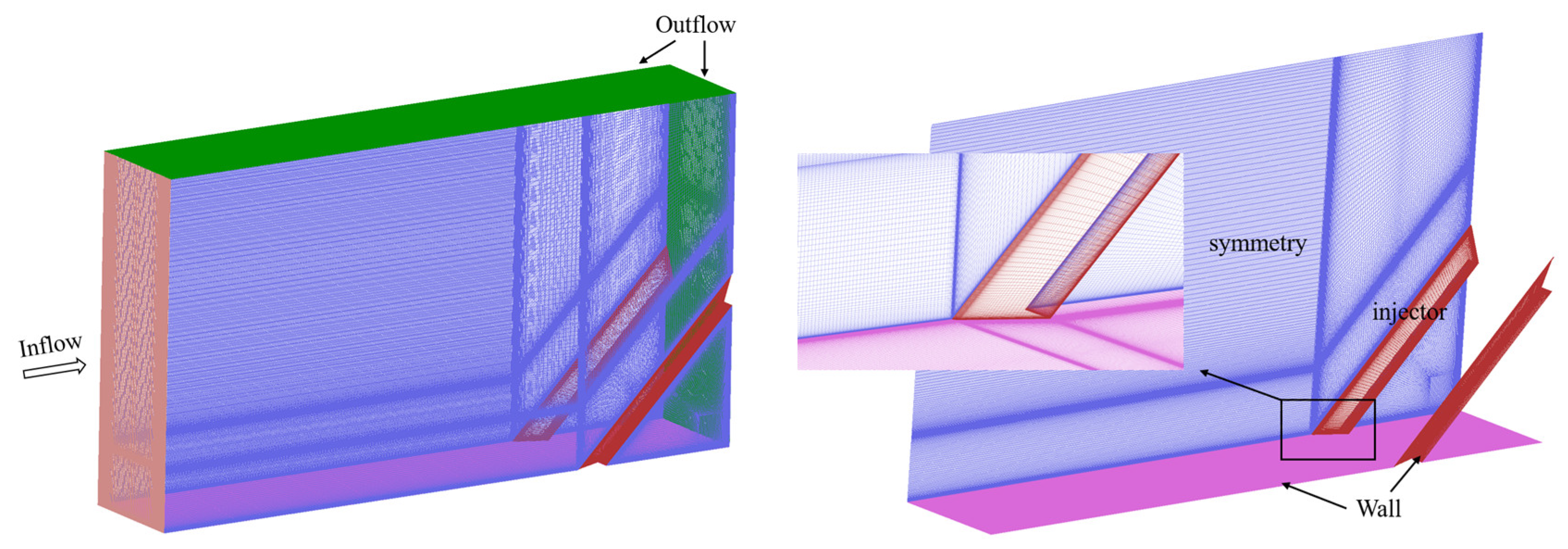
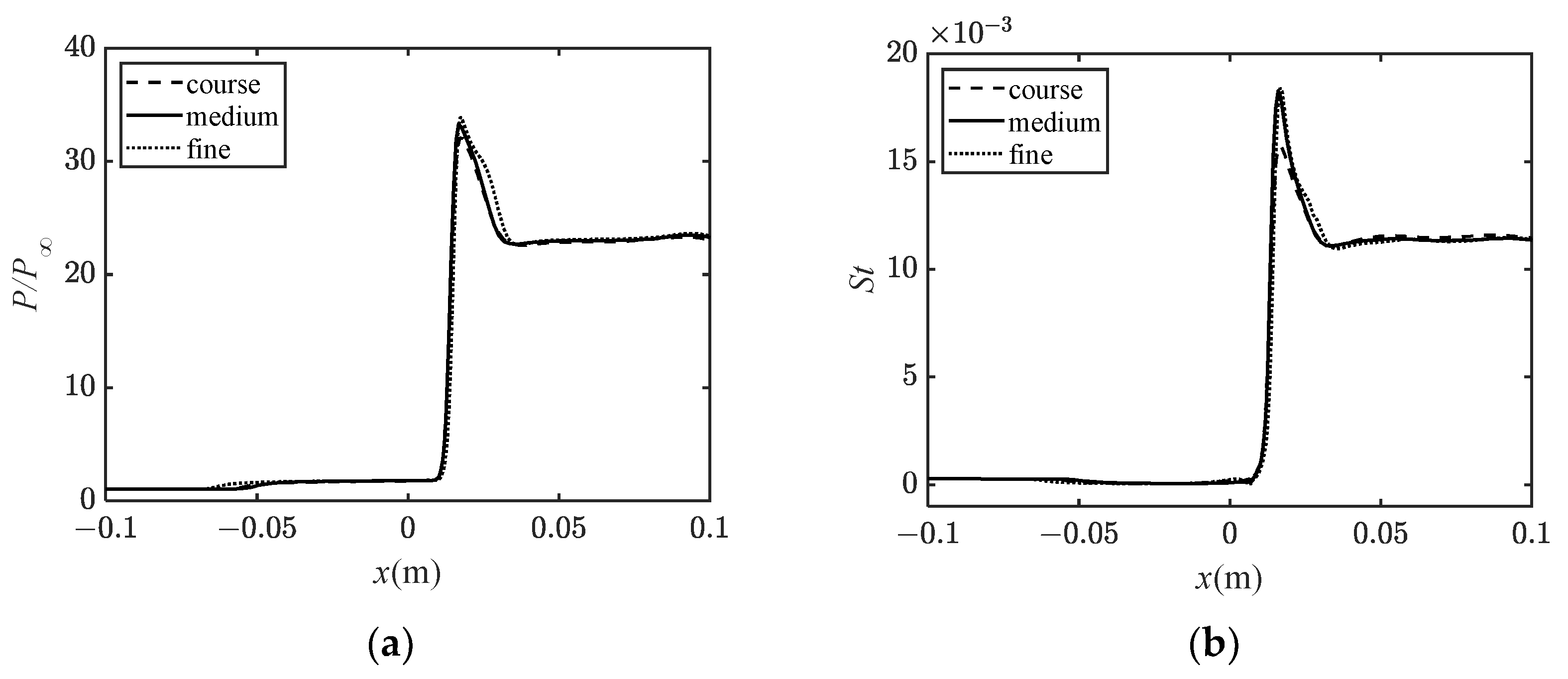



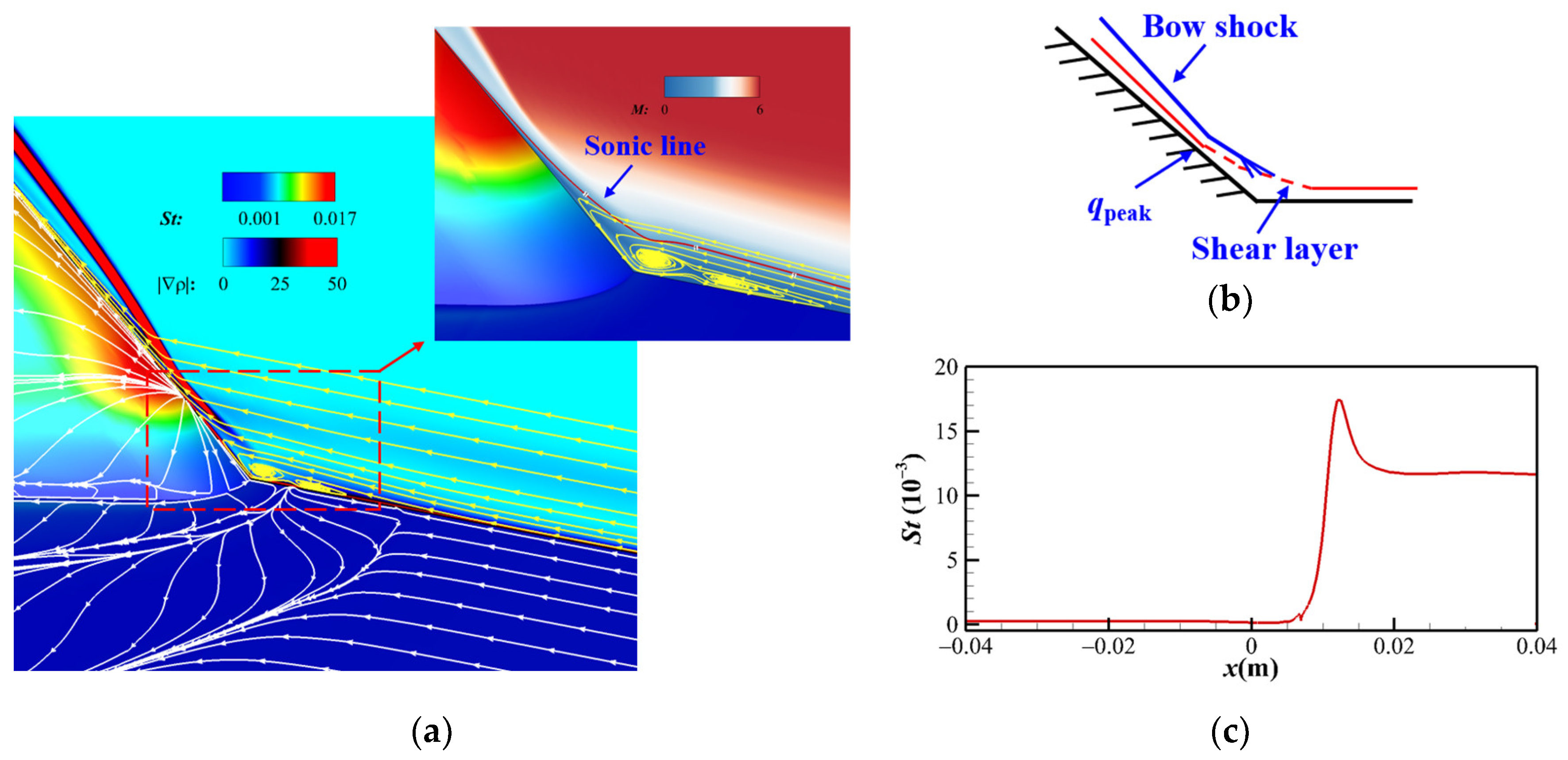

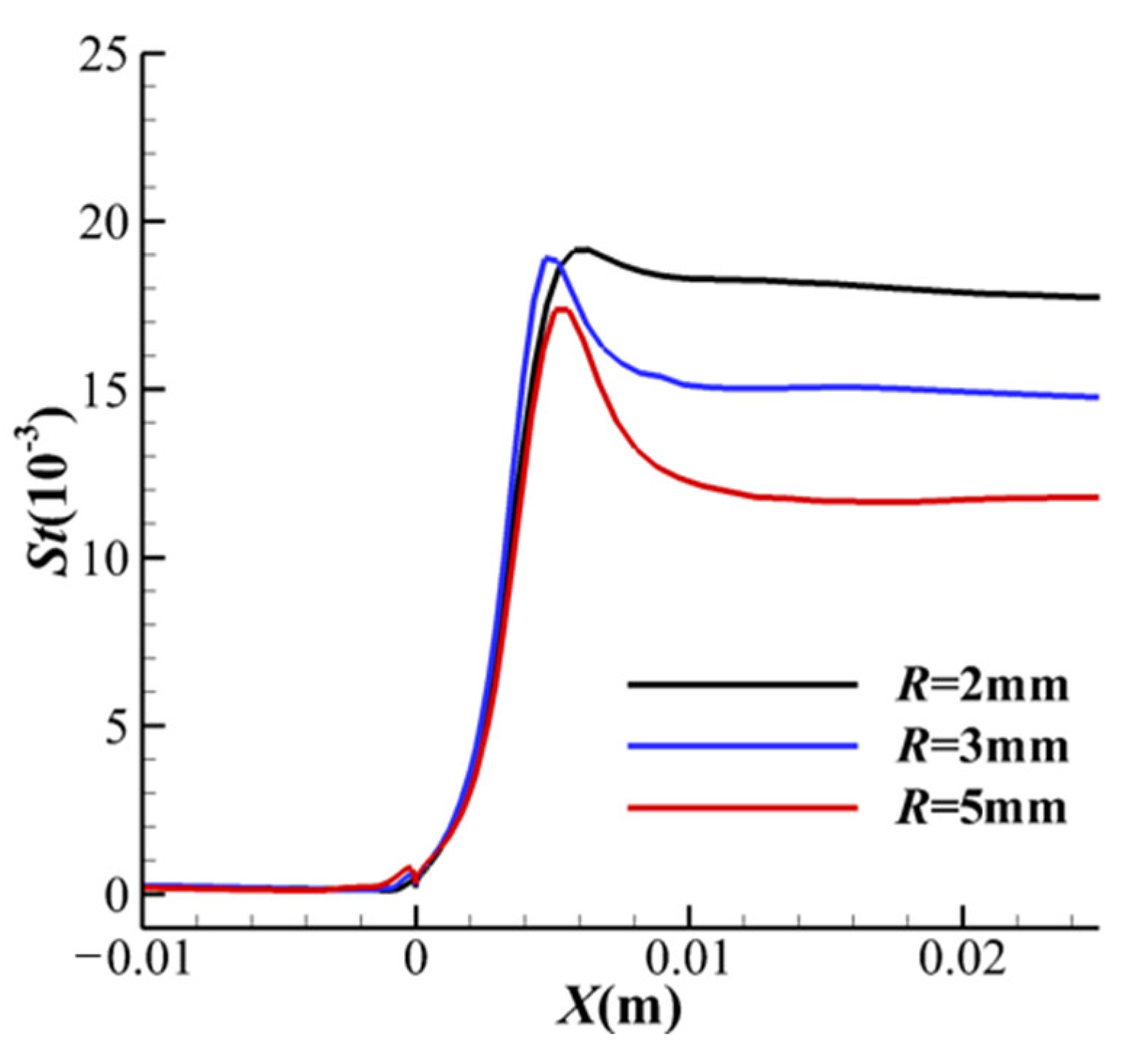
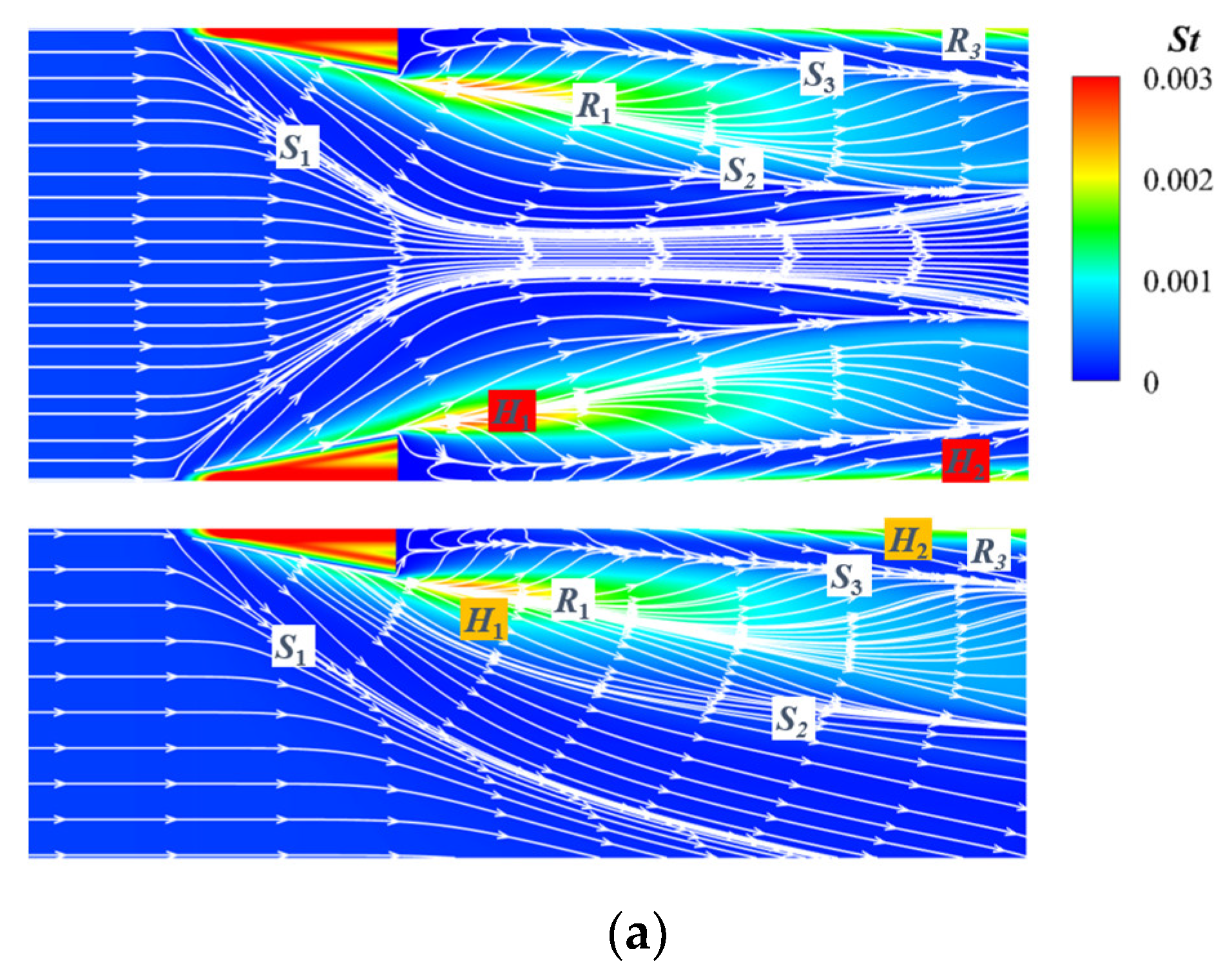
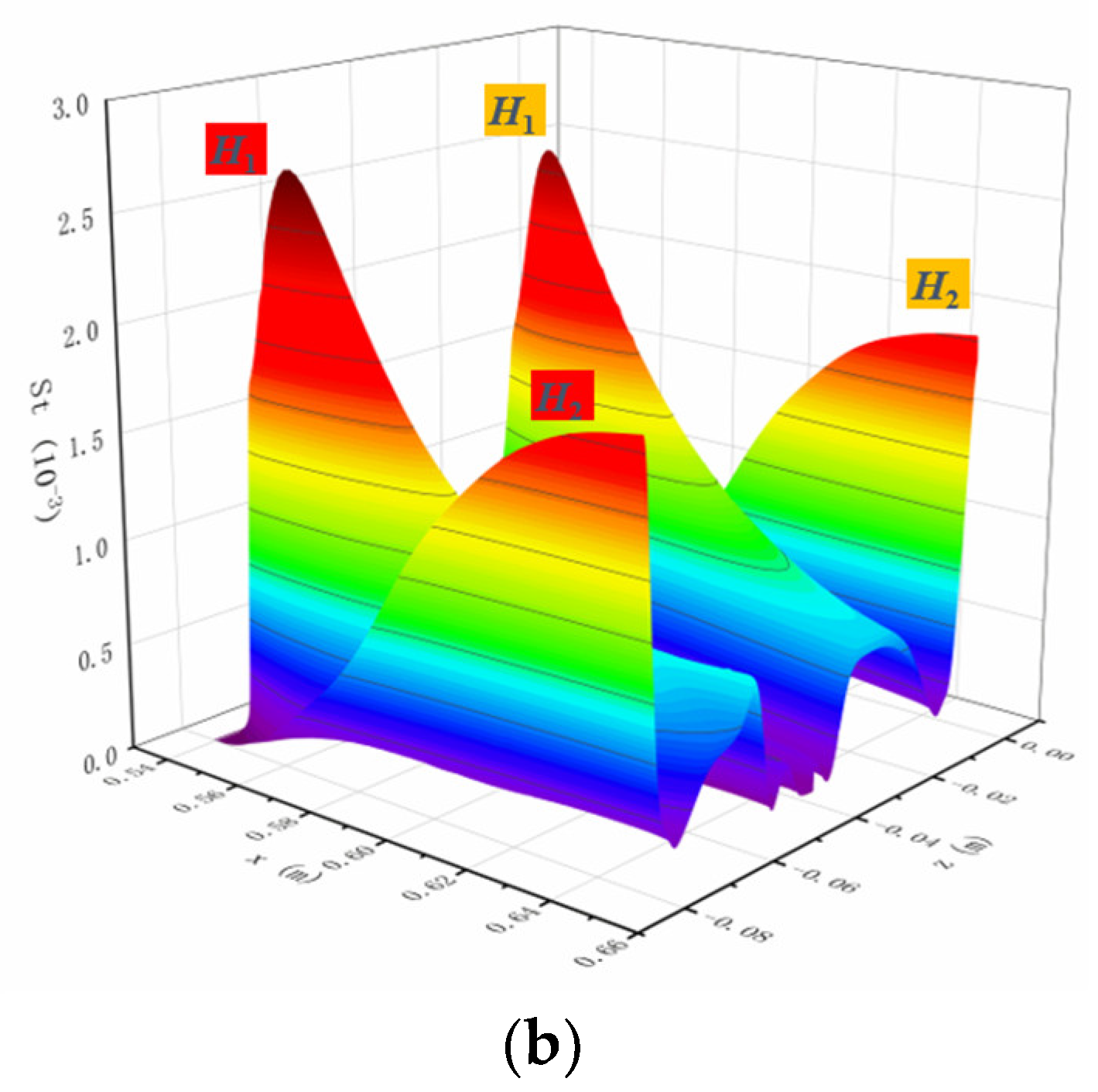
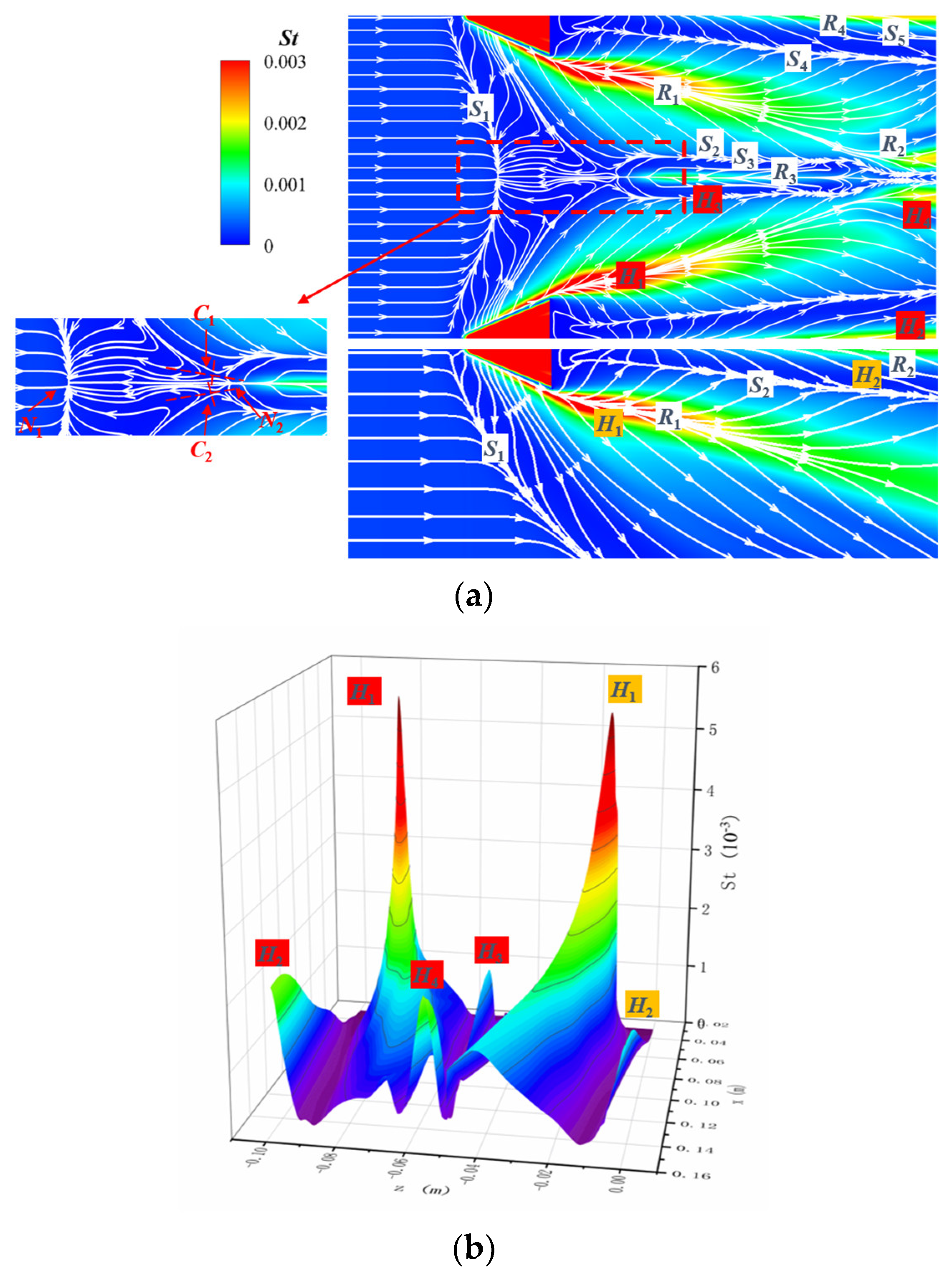

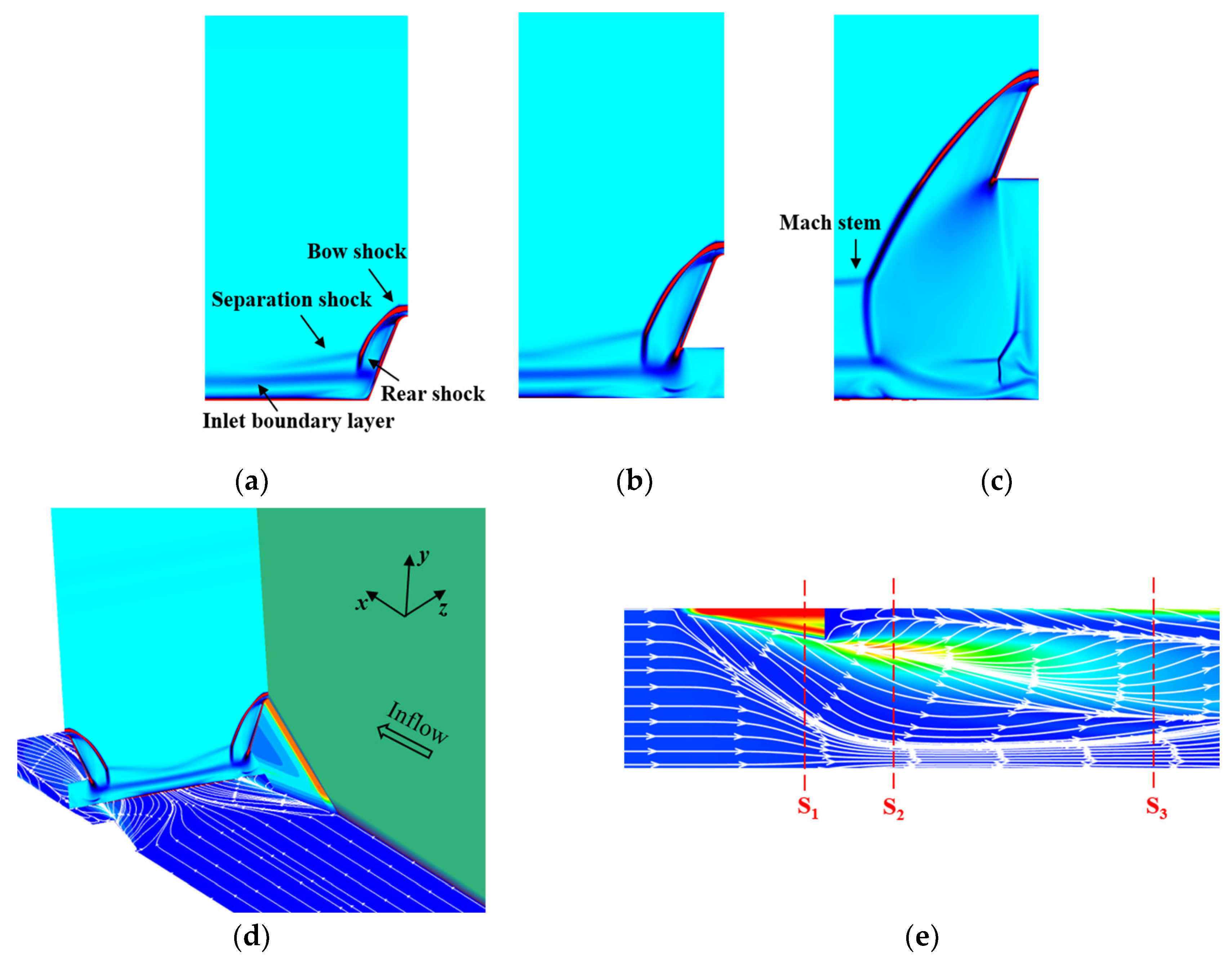

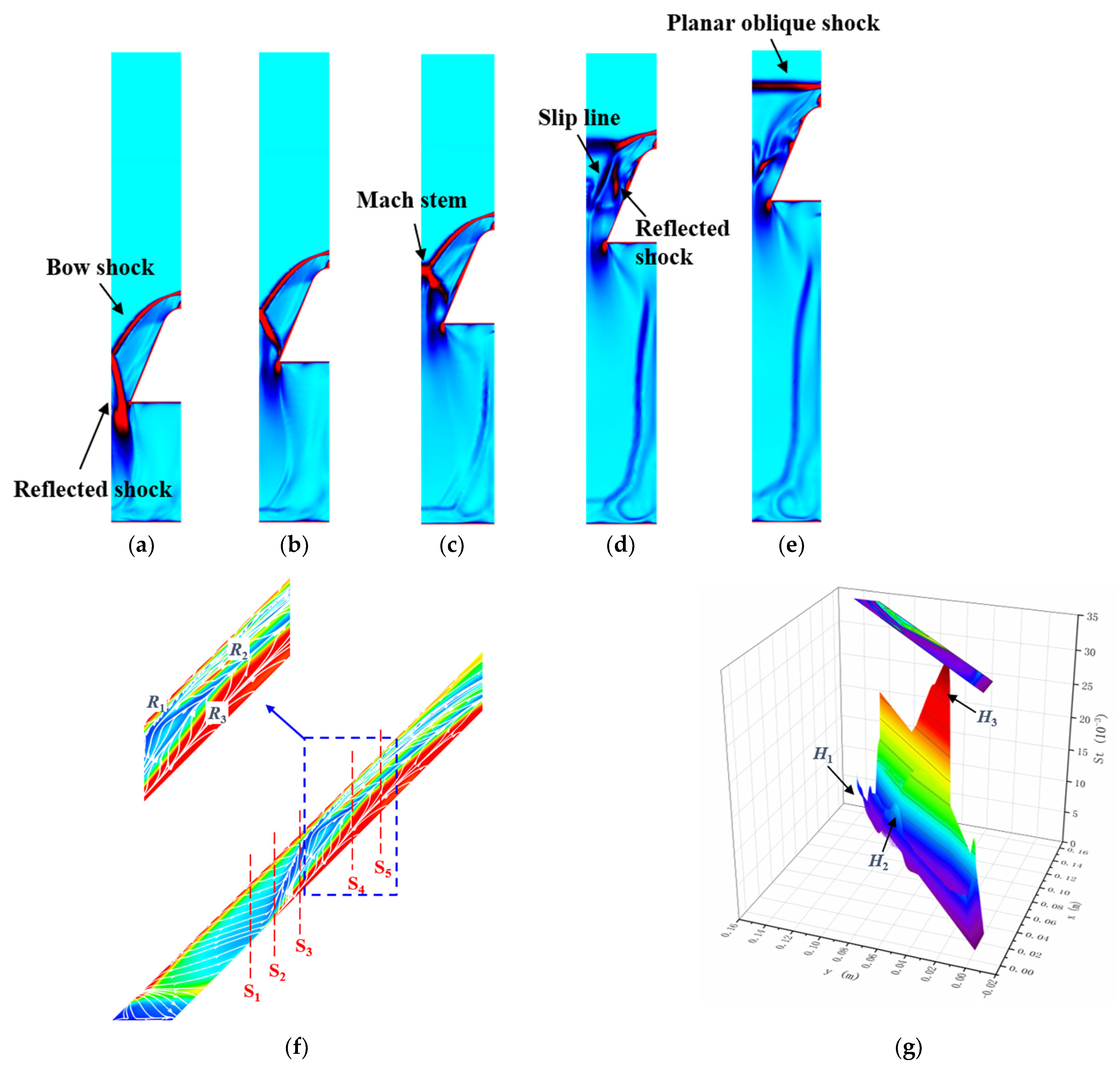
| Parameter | Values |
|---|---|
| Mach number Ma | 5.9 |
| Static pressure P∞ (Pa) | 1410 |
| Static temperature T∞ (K) | 435 |
| Free stream velocity U∞ (m/s) | 2471 |
| Reynolds number Re∞ | 1.1 × 106 |
| Number of Cells | Surface Cell Thickness, ×10−6 m | Non-Dimensional Wall Distance y+ | Peak Pressure | Peak St Number, ×10−3 | |
|---|---|---|---|---|---|
| Coarse | 16.3 million | 5 | <1 | 32.10 | 15.68 |
| Medium | 28.7 million | 3 | <1 | 33.31 | 18.29 |
| Fine | 60.0 million | 2 | <1 | 33.92 | 18.42 |
Disclaimer/Publisher’s Note: The statements, opinions and data contained in all publications are solely those of the individual author(s) and contributor(s) and not of MDPI and/or the editor(s). MDPI and/or the editor(s) disclaim responsibility for any injury to people or property resulting from any ideas, methods, instructions or products referred to in the content. |
© 2023 by the authors. Licensee MDPI, Basel, Switzerland. This article is an open access article distributed under the terms and conditions of the Creative Commons Attribution (CC BY) license (https://creativecommons.org/licenses/by/4.0/).
Share and Cite
Yang, F.; Lin, M.; Hu, Z.; Han, G. Numerical Study on the Aerodynamic Heating Characteristics of the Cantilevered Injection System for Oblique Detonation Engine Inlets. Aerospace 2023, 10, 897. https://doi.org/10.3390/aerospace10100897
Yang F, Lin M, Hu Z, Han G. Numerical Study on the Aerodynamic Heating Characteristics of the Cantilevered Injection System for Oblique Detonation Engine Inlets. Aerospace. 2023; 10(10):897. https://doi.org/10.3390/aerospace10100897
Chicago/Turabian StyleYang, Fan, Mingyue Lin, Zongmin Hu, and Guilai Han. 2023. "Numerical Study on the Aerodynamic Heating Characteristics of the Cantilevered Injection System for Oblique Detonation Engine Inlets" Aerospace 10, no. 10: 897. https://doi.org/10.3390/aerospace10100897
APA StyleYang, F., Lin, M., Hu, Z., & Han, G. (2023). Numerical Study on the Aerodynamic Heating Characteristics of the Cantilevered Injection System for Oblique Detonation Engine Inlets. Aerospace, 10(10), 897. https://doi.org/10.3390/aerospace10100897






